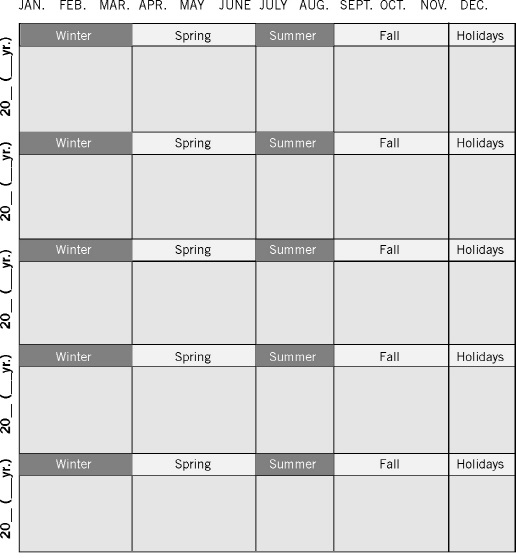

My interest is in the future, because I’m going to spend the rest of my life there.
—Charles Kettering
Do you remember your mother (or a schoolteacher) saying you could be any-thing you want to be if you simply dream it and work hard for it? I don’t know about you, but there are still a ballerina and a figure skating champion within me waiting to burst onto the scene. How about you? Perhaps a musician, a teacher, a dentist, a most valuable player, or a rookie of the year?
Life doesn’t always result in a dream come true. On the other hand, some of our experiences are better than anything we could have dreamed or imagined. But one thing is certain: you have a future, and it begins tomorrow. What do you want it to be like? Following are some practical step-by-step strategies to help you shape your future and to find satisfaction on the journey.
Time Management Under and Over Thirty Years Old
Time management experts claim that if you are thirty years old or under, you should make three-year plans. If you’re over thirty, make five-year plans. Why? I suspect it’s because life changes happen more rap-idly when you’re in your twenties. After age thirty, past choices tend to dictate your direction and the rate of change slows down.
When I ask my audiences to put together a five-year plan, they are skeptical. But when I ask them how old they are now and how old they’ll be in five years, they are astonished. One lady said, “I never thought I’d be that old. I only think of my sister as being that age . . . or my mother!” Suddenly the reality of the passing of time hits.
The reality is that if you don’t plan for your future, other people (boss, coworkers, spouse, children) will plan your life for you, or your daily routine will swallow up any chance you have to change your lifestyle. That doesn’t have to be true—but too often it is. Don’t let it happen to you.
How Can I Possibly Make a Plan for My Future?
If we were to sit down together over coffee, I would give you the following five-year calendar and walk you through the following steps. And by the end, you would begin to see some new possibilities for your life.

| My “15 Item Wish List” for the Next Five Years: | “More Of” List | “Less Of” List |
| Be debt free and have a savings. | More action | Less routine |
| Take the kids to Disneyland. | More purpose | Less maintenance |
| Get son through high school and off to college. | More family memories | Less busyness Less car repairs |
| Finish my degree in two years. | More income | Less computer |
| Celebrate 50th birthday in Hawaii. | More results | problems |
Fill in your calendar with this information:
1. In the left margin, write the year and your age for the next five years. This action, more than any other, opens your eyes to why you need to plan ahead. At the end of five years, you’ll be five years older whether you make a plan or not.
2. Put a star on key personal dates: Start with your own birthday. Then add significant anniversaries and children’s names, ages, and grade levels in September for each year. Include birthdays of parents, children, grandchildren, nieces and nephews, and even your grandparents if they are still alive. This exercise will help you see how quickly time passes and how little time you have with your loved ones. It’s a reminder to make the most of it.
3. Fill in any future events, such as a special vacation, date to start graduate school, or job status change. The more information you include, the better.
Think of Fifteen Things You’d Like to Do
Typically, either people have too many things they want to do “someday,” or they have no idea what they want to do. I find it’s best to hone in on real things that are important to you. For example, make a wish list of things you’d like to see happen in the next five years:
 Take the family to Disneyland.
Take the family to Disneyland.
 Go to the Super Bowl.
Go to the Super Bowl.
 See our children graduate from high school.
See our children graduate from high school.
 Oldest child and I go to college and graduate together.
Oldest child and I go to college and graduate together.
 Find a good-paying job for college bills.
Find a good-paying job for college bills.
 Find an exercise program that is fun.
Find an exercise program that is fun.
 Purchase a new computer.
Purchase a new computer.
 Buy a new car.
Buy a new car.
 Triple our savings.
Triple our savings.
 Empty the storage unit and save money.
Empty the storage unit and save money.
 Upgrade the carpets.
Upgrade the carpets.
 Vacation in Hawaii.
Vacation in Hawaii.
Pencil In Your Wishes for Each Quarter of the Year
Studies show people are willing to do anything for ninety days because it’s a reasonable length of time. That’s a good way to plan quarterly goals. In our calendar, we’re going to place three of our listed desires in each of the next five years, leaving free one of the seasons per year.
By the way, it’s best not to plan anything between Thanksgiving and New Year’s because of the busyness of the holidays.
FIFTEEN THINGS I’D LIKE TO DO IN THE NEXT FIVE YEARS . . .
1.
2.
3.
4.
5.
6.
7.
8.
9.
10.
11.
12.
13.
14.
15.

* Pencil in your projects and dreams—one per season over five years.
Dreams and Intentions Are Powerful
I remember when I first learned the power of dreams. My husband was asked to teach a class on “life strategies.” I sat in the audience supporting him, and in the second session he asked, “What do you picture yourself doing five years from now?”
I thought about our nine-month-old entering kindergarten in five years, and I pictured that in five years, I would probably have a toddler and a new baby. Not that I harbored aspirations to be a mother as my main goal in life, but that did seem like a logical expectation. And sure enough, five years later, we did end up with three children under six years of age. They are now young adults whom we enjoy.
Include “More Of” and “Less Of” Lists
Whenever you reevaluate your time, make two lists: one for things you want “more of ” and one for the things you want “less of.” Granted, some of the items on these lists will be based on emotions, but include them anyway. Then change the negatives and plan for positives.
When you decide the “what” in life, your mind goes to work on the “how.” Be expectant and get ready to walk into your future.
It’s Your Time
Jump-Start Your Dreams with a Five-Year Calendar (Time Strategy #1)
■ List your “more of ” and “less of ” time wishes.
■ Brainstorm your fifteen-item goal (wish) list.
■ Print the five-year calendar and add your fifteen goals, one per season.
Reduce your plan to writing. The moment you complete this, you will have definitely given concrete form to the intangible desire.
—Napoleon Hill